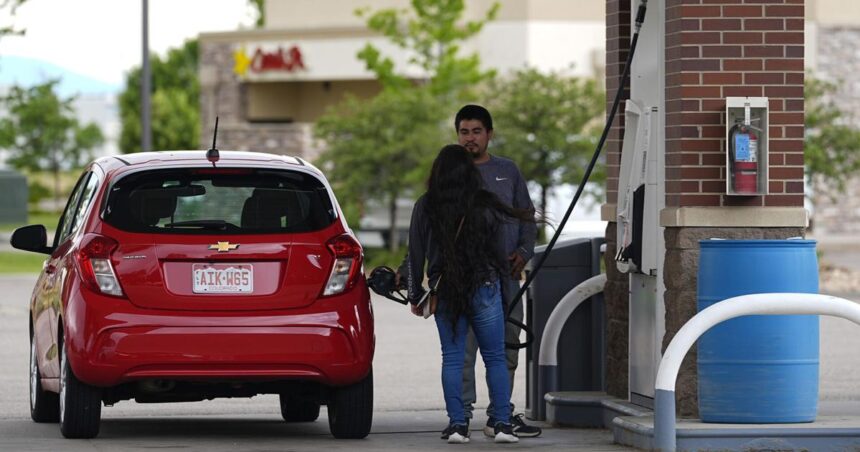WASHINGTON — Inflation in the United States cooled in June for a third straight month, a sign that the worst price spike in four decades is steadily fading and may soon usher in interest rate cuts by the Federal Reserve.
In a better-than-expected report, consumer prices declined 0.1% from May to June after having remained flat the previous month, the Labor Department said Thursday. It was the first monthly decline in overall inflation since May 2020, when the economy was paralyzed by the COVID-19 pandemic.
Measured from one year earlier, prices were up 3% in June, cooler than the 3.3% annual rate in May.
The latest inflation readings will likely help convince the Fed’s policymakers that inflation is returning to their 2% target. A brief pickup in inflation early this year caused the officials to scale back their expectations for interest rate cuts. Policymakers said they would need to see several months of mild price increases to feel confident enough to cut their key rate from its 23-year high.
People are also reading…
Should inflation remain low through the summer, most economists expect the Fed to begin cutting its benchmark rate in September.
“This confirms that there is very little chance of inflation re-accelerating and that it’s time for some rate cuts from the Fed,” said Luke Tilley, chief economist at Wilmington Trust, a wealth management firm.
Tilley noted that measures of rent and homeownership costs cooled significantly last month, a long-awaited development. Rental prices typically don’t change much from month to month, he noted, which means that the slower price increases in June will probably continue.
Mary Daly, a key Fed official, also suggested Thursday the central bank should cut rates soon. Daly, president of the Fed’s San Francisco branch, said she believed slowing inflation and a cooling job market justify a reduction in interest rates. She did not address the specific timing of any rate cut.
“I see it as likely that some policy adjustments will be warranted,” Daly said on a conference call with reporters.
Even as inflation slows, the costs of food, rent, health care and other necessities remain much higher than they were before the pandemic — a source of public discontent and a potential threat to President Joe Biden’s re-election bid.
In June, gas prices fell for a second straight month, tumbling 3.8% on average nationwide from May. Gas prices are now down 2.5% from a year ago. They picked up this month and averaged $3.54 nationwide Thursday, according to AAA, up 10 cents from a month earlier.
Grocery prices ticked up by a slight 0.1% last month, the first increase in five months, and are 1.1% higher than a year ago. Food prices are still up, on average, 21% from March 2021, when inflation started to surge, though Americans’ average wages have also risen since then.
Excluding volatile food and energy costs, so-called core prices climbed just 0.1% from May to June, below the 0.2% increase in the previous month. Measured from 12 months earlier, core prices rose 3.3% in June, down from 3.4% May. Core prices are thought to provide a particularly telling signal of where inflation is likely headed.
Used car prices, which soared during the recovery from the pandemic, have dropped 10.1% in the past year.
Rental and homeownership costs, which make up more than one-third of the entire consumer price index, rose at a slower pace last month, up 0.3% from May to June. That is the mildest such increase in nearly three years, and it could signal that a long-awaited slowdown in rental price increases has finally arrived.
Compared with a year earlier, rents in June were still up 5.1%, a much faster rate than before the pandemic.
Most other major drivers of inflation over the past three years — groceries, used cars, gas — either leveled off or declined. Rental price increases remained persistently high until June.
“This is a really, really good sign that the (price) weakness that we’ve been expecting for a year and a half is finally starting to occur,” said Alan Detmeister, an economist at UBS Investment Bank. The pullback in housing costs, he said, “will make (Fed officials) feel that the slowing in inflation is a little more sustainable.”
Still, a jump in her rent at the start of this year delivered a painful blow to Deborah Stettler’s finances. Stettler, a 51-year old resident of Quincy, Massachusetts, said her rent soared in January from $1,500 a month to $2,000.
A single mother with a 16-year old son, Stettler is also still struggling with the sharp run-up in food prices over the past three years. She gets about half her family’s food from a local food pantry. For the rest, she looks for sales at grocery stores.
Stettler landed a new job about nine months ago, in children’s services, after having worked before then at a YMCA branch.
“Rent has gone up, food has gone up, the pay doesn’t go up,” she said. “I’m still going to the food pantry for food help, because by the time you pay all your bills, you don’t really have a lot of money left for food.”





